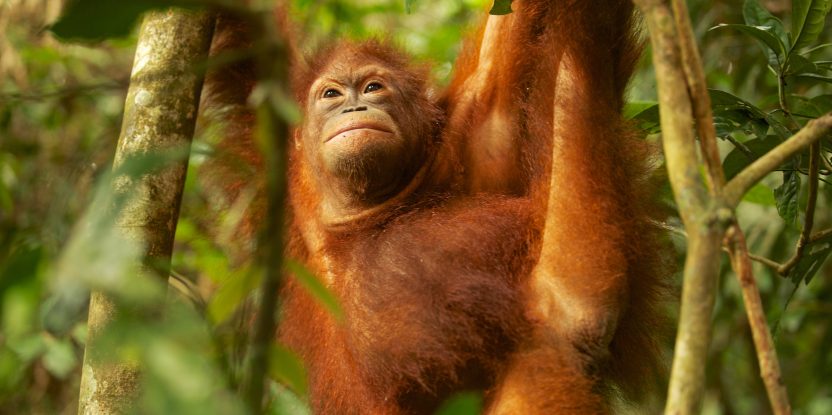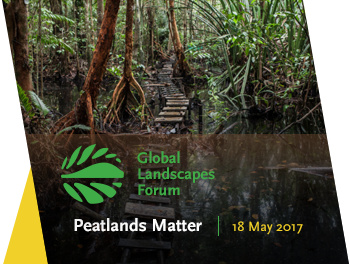
What do a hairy-nosed otter, a Sumatran tiger and a white-backed Malayan Tapir have in common? Not only are they some of the rarest animals on planet earth, they spend most of their days snuffling through peatlands.
“Conversations about protecting peatlands tend to focus on the carbon they store that can be released into our atmosphere and cause climate change,” says Sofyan Kurnianto, a PhD researcher associated with the Center for International Forestry Research (CIFOR).
“However, they are also important sites of biodiversity and provide other ecosystem services and we urgently need to protect the animals and plants that live there.”
The flora and fauna found thriving on peat are about as varied as peatlands themselves. Much depends on where on the planet the peat is located, as well as the amount of forest cover and factors such as the nutrients in the ecosystem and the presence of water pools.
ANIMAL KINGDOM
In non-tropical peatlands, in temperate and boreal areas towards the poles, animals like moose, black bears, wolves and reindeer wander the terrain in search of food. Although a diverse range of fish is not found in water in peatlands in countries like Canada, birds from waterfowl to songbirds to birds of prey abound, many stopping in on migratory routes. Elsewhere, small animals like mice and squirrels can be found, as well as insects like butterflies, spiders and mosquitoes and water-dwellers like beavers, newts and frogs.
Tropical peatlands burst with a huge diversity of freshwater fish – including one of the smallest fish in the world, Peadocypris progenetica. They are also home to a range of endangered species such as orangutans, rhinoceroses, Sunda clouded leopards, Sumatran tigers, tapirs, false gharials, Storm’s storks, white-winged ducks and freshwater turtles. An inventory in tropical peat swamp forests in Southeast Asia found that 45 percent of mammals and 33 percent of birds identified are listed by the International Union for Conservation of Nature (IUCN) as either near threatened, vulnerable or endangered.
INVENTIVE VEGETATION
Plants are forced to adapt.
“Peatlands are commonly characterized with acidic water and soil and in many peatlands there is low oxygen and few nutrients,” says Kurnianto. “It is not always the most inviting environment.”
Accordingly, hardy sphagnum mosses are the most common sight in non-tropical peatlands – with herbs, ferns and grasses establishing themselves in fens and low-lying shrubs like bog laurel sprouting where their name would suggest. Some plants take more adventurous steps to survive. Rhododendrons and orchids use a symbiosis with fungi in their roots- called mycorrhizae – to get extra nutrients. Others opt for a carnivorous lifestyle. Pitcher plants and sundews capture small insects to make up for the lack of nutrients from the soil.
In the tropics, a plethora of orchids, medicinal plants and insect-trappers like nepenthes pitcher plants find refuge in peat forests and mangroves. In fact, peat swamp forests have the highest floral diversity of all of the world’s peatlands- with more than one in 10 of the plants recorded in them existing only in that habitat. Most of these plants are trees – including giant tropical varieties like Meranti, Ramin and Ironwood – followed by climbers.
PEATLANDS UNDER THREAT
Unfortunately, as peatlands around the world face growing pressures and threats, so too does their biodiversity. Northern peatlands and their permafrost regions are changing under the warming temperatures of climate change and many countries in Western Europe have over-exploited their peat stores. However, in tropical regions in countries like Indonesia, some peatlands are disappearing altogether as they are drained, logged, burned and converted into large scale agricultural plantations for products like palm oil.
“The homes of endangered species are being destroyed,” says Kurnianto. “Many animals are killed in fires, their food source is taken away, or they are driven by smoke to take dangerous journeys to find new habitats.”
Due to the destruction of tropical peat swamp forests, today there are only 400 Sumatran tigers living in the wild and the number of Sumatran orangutans has dropped by 80 percent over the last 75 years. As highly mobile animals, orangutans require large areas of forest for their habitat. During fires, females, who tend to stick closer to home, are most likely to get burned. In their search for safety they risk being shot by humans who view them as pests.
Increasingly, projects to restore peatlands and prevent carbon release are being urged to include a strong biodiversity component – focusing on reintroducing plant and animal life.
“Any tropical peat restoration project has to have at least two elements: re-wetting of land and re-vegetation with endemic species,” says Kurnianto. “In Indonesia, we commonly try to replant things like the sago palm or jelutung.”
Several projects have shown that replanting native vegetation on degraded peatlands is a way to develop alternative income sources for communities living in these areas. It also keeps peatlands healthy, protects local plantlife and provides food and habitat for animals.
However, the balance between conserving peatlands and allowing development can be hard to strike, as many communities place greater value on the economic benefits of burning peatland for agricultural use. These tensions are set to be discussed at the upcoming Global Landscapes Forum: Peatlands Matter in Jakarta, Indonesia, this May.
As forest cover declines, and the hundreds of thousands of animals and plants on peatlands face increasing peril, speedy consensus could be life-saving.
We want you to share Forests News content, which is licensed under Creative Commons Attribution-NonCommercial-ShareAlike 4.0 International (CC BY-NC-SA 4.0). This means you are free to redistribute our material for non-commercial purposes. All we ask is that you give Forests News appropriate credit and link to the original Forests News content, indicate if changes were made, and distribute your contributions under the same Creative Commons license. You must notify Forests News if you repost, reprint or reuse our materials by contacting forestsnews@cifor-icraf.org.
